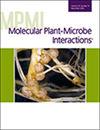求助PDF
{"title":"<i>Zymoseptoria tritici</i> Shows Local Differences in Within-Field Diversity and Effector Variation.","authors":"Andrea Tobian Herreno, Pu Huang, Isabella Siepe, Remco Stam","doi":"10.1094/MPMI-01-25-0006-FI","DOIUrl":null,"url":null,"abstract":"<p><p><i>Zymoseptoria tritici</i> is a cosmopolitan hemibiotrophic wheat pathogen with a high mutation rate and a mixed reproduction system, with sexual and asexual cycles occurring within the same disease cycle. This leads to challenges in traditional farming management. For successful integrated pest management, especially for surveys of new aggressive lineages, it is critical to understand population diversity in the field. We look at whole-genome sequence data for three datasets to differentiate within field diversity in fields of similar size: one dataset from a newly sampled field population from the United Kingdom and two publicly available datasets from fields from the United States and Switzerland. This survey of genetic variation allows us to describe in detail how variable the field populations are and offers insight into the dynamics of the disease in a snapshot per field. Inspection of population structure and diversity features, such as minor allele frequency distribution and clonality, show no within-field structure, the most abundant single-nucleotide polymorphisms are present in low frequency, and European fields have higher clonality. Knowing that effectors play particularly important roles in (a)virulence, we specifically assess effector diversity characteristics. On a whole-genome scale, we can see separation of the populations at the regional scale, but we do not find such separation for the effectors. Moreover, we find that multiple effector haplotypes can be found interspersed within the field and even occur within what have been considered clonal isolates or isolates from a single lesion. Our analyses highlight that within-field <i>Z. tritici</i> genetic variation is higher than previously reported. Our finding that multiple effector haplotypes can be found within a single lesion might explain the large resistance gene-breaking potential of <i>Z. tritici</i>. [Formula: see text] Copyright © 2025 The Author(s). This is an open access article distributed under the CC BY-NC-ND 4.0 International license.</p>","PeriodicalId":19009,"journal":{"name":"Molecular Plant-microbe Interactions","volume":" ","pages":"385-399"},"PeriodicalIF":3.4000,"publicationDate":"2025-05-01","publicationTypes":"Journal Article","fieldsOfStudy":null,"isOpenAccess":false,"openAccessPdf":"","citationCount":"0","resultStr":null,"platform":"Semanticscholar","paperid":null,"PeriodicalName":"Molecular Plant-microbe Interactions","FirstCategoryId":"99","ListUrlMain":"https://doi.org/10.1094/MPMI-01-25-0006-FI","RegionNum":3,"RegionCategory":"生物学","ArticlePicture":[],"TitleCN":null,"AbstractTextCN":null,"PMCID":null,"EPubDate":"2025/6/27 0:00:00","PubModel":"Epub","JCR":"Q2","JCRName":"BIOCHEMISTRY & MOLECULAR BIOLOGY","Score":null,"Total":0}
引用次数: 0
引用
批量引用
Abstract
Zymoseptoria tritici is a cosmopolitan hemibiotrophic wheat pathogen with a high mutation rate and a mixed reproduction system, with sexual and asexual cycles occurring within the same disease cycle. This leads to challenges in traditional farming management. For successful integrated pest management, especially for surveys of new aggressive lineages, it is critical to understand population diversity in the field. We look at whole-genome sequence data for three datasets to differentiate within field diversity in fields of similar size: one dataset from a newly sampled field population from the United Kingdom and two publicly available datasets from fields from the United States and Switzerland. This survey of genetic variation allows us to describe in detail how variable the field populations are and offers insight into the dynamics of the disease in a snapshot per field. Inspection of population structure and diversity features, such as minor allele frequency distribution and clonality, show no within-field structure, the most abundant single-nucleotide polymorphisms are present in low frequency, and European fields have higher clonality. Knowing that effectors play particularly important roles in (a)virulence, we specifically assess effector diversity characteristics. On a whole-genome scale, we can see separation of the populations at the regional scale, but we do not find such separation for the effectors. Moreover, we find that multiple effector haplotypes can be found interspersed within the field and even occur within what have been considered clonal isolates or isolates from a single lesion. Our analyses highlight that within-field Z. tritici genetic variation is higher than previously reported. Our finding that multiple effector haplotypes can be found within a single lesion might explain the large resistance gene-breaking potential of Z. tritici . [Formula: see text] Copyright © 2025 The Author(s). This is an open access article distributed under the CC BY-NC-ND 4.0 International license.
小麦酵母在田间多样性和效应变异方面存在局部差异。
小麦酵母菌是一种世界性的半生物营养型小麦病原菌,具有高突变率和混合繁殖系统,在同一疾病周期内发生有性和无性循环。这给传统的农业管理带来了挑战。为了成功地进行有害生物综合治理,特别是为了调查新的侵略性品系,了解田间种群多样性是至关重要的。我们研究了三个数据集的全基因组序列数据,以便在相似规模的领域中区分领域多样性:一个数据集来自英国新采样的领域种群,两个公开的数据集来自美国和瑞士的领域。这种遗传变异的调查使我们能够详细描述田间种群的变化,并在每个田间的快照中深入了解疾病的动态。从种群结构和多样性特征(如次要等位基因频率分布和克隆性)的检验中,没有发现场内结构,snp最丰富的是在低频,欧洲田区具有较高的克隆性。知道效应物在(a)毒力中起着特别重要的作用,我们特别评估了效应物的多样性特征。在全基因组尺度上,我们可以看到种群在区域尺度上的分离,但我们没有发现效应体的这种分离。此外,我们发现多个效应单倍型散布在该领域,甚至出现在被认为是克隆分离株或来自单一病变的分离株中。
本文章由计算机程序翻译,如有差异,请以英文原文为准。

 求助内容:
求助内容: 应助结果提醒方式:
应助结果提醒方式:


